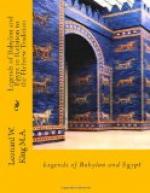In the Semitic Version Ut-napishtim, who tells the story in the first person, then says that he “understood”, and that, after assuring Ea that he would carry out his commands, he asked how he was to explain his action to “the city, the people, and the elders”; and the god told him what to say. Then follows an account of the building of the ship, introduced by the words “As soon as the dawn began to break”. In the Sumerian Version the close of the warning, in which the ship was probably referred to, and the lines prescribing how Ziusudu carried out the divine instructions are not preserved.
It will be seen that in the passage quoted from the Semitic Version there is no direct mention of a dream; the god is represented at first as addressing his words to a “house of reeds” and a “wall”, and then as speaking to Ut-napishtim himself. But in a later passage in the Epic, when Ea seeks to excuse his action to Enlil, he says that the gods’ decision was revealed to Atrakhasis through a dream.(1) Dr. Poebel rightly compares the direct warning of Ut-napishtim by Ea in the passage quoted above with the equally direct warning Ziusudu receives in the Sumerian Version. But he would have us divorce the direct warning from the dream-warning, and he concludes that no less than three different versions of the story have been worked together in the Gilgamesh Epic. In the first, corresponding to that in our text, Ea communicates the gods’ decision directly to Ut-napishtim; in the second he sends a dream from which Atrakhasis, “the Very Wise one”, guesses the impending peril; while in the third he relates the plan to a wall, taking care that Ut-napishtim overhears him.(2) The version of Berossus, that Kronos himself appears to Xisuthros in a dream and warns him, is rejected by Dr. Poebel, who remarks that here the “original significance of the dream has already been obliterated”. Consequently there seems to him to be “no logical connexion” between the dreams or dream mentioned at the close of the Third Column and the communication of the plan of the gods at the beginning of the Fourth Column of our text.(3)
(1) Cf. l. 195 f.; “I
did not divulge the decision of the
great gods. I caused
Atrakhasis to behold a dream and thus
he heard the decision
of the gods.”




